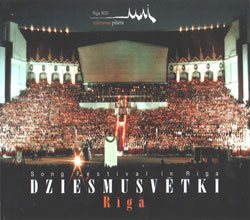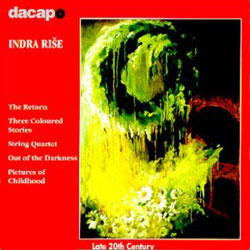
When the editor asked if I would be interested in reviewing a new compact disc of Gregorian chant from the Schola Cantorum Riga, my curiosity was piqued and I agreed. I couldn’t recall having come across a recording of medieval religious chant from a Latvian source before.
When the disc arrived, I took a quick look at it, admired the handsome packaging, then put it aside until I could spend some time with it. Eventually, I settled down with the disc, hoping for some pleasant listening. As sounds emerged from my headphones, I sat up in amazement. What’s this? A synthesizer?! I thought this was a disc of vocal music! Taking a more careful look at the back of the CD folder I examined at the fine print and saw that, in addition to the four vocalists, the group’s leader was listed as playing “keyboards.” Eventually I did hear voices, singing the traditional chant I had been expecting to hear, but the electronics continued in the background throughout the entire disc.
So, what did I make of this unexpected accompaniment? My first reaction was shock. Why would anyone want to “enhance” these beautiful, unaccompanied tunes that had survived over the centuries and are still being sung plain and unadorned to the glory of God? My second reaction was anger. The disc was credited as having been “arranged and produced” by Raimonds Tiguls, the group’s leader. However, nowhere on the packaging does it clearly state that all the tracks feature a synthesized backdrop of sound. Inside the trifold jacket, the skimpy notes (three sentences!) open with the statement “This album is based on traditional Gregorian chant…” but provides no rationale for the arrangements.
Well, in all fairness, plainchant did undergo an evolution over the centuries, serving as a basis for much of the glorious polyphony that presaged choral music as we know it. However, this was organic development that grew directly from the chant itself and the resulting polyphony successfully stood on its own, with the original chant often submerged and only subtly apparent. Instrumentally, many of Johann Sebastian Bach’s organ preludes based on Lutheran chorales were created in much the same fashion, with composers before and after him applying the same compositional principles, with varying degrees of subtlety and complexity.
So, there is precedent for using chant as a basis for new musical works. But that’s not what’s happening here. These newly composed electronic backgrounds are mostly an annoying, unnecessary distraction rather than an outgrowth or development of the original melodies, and often seem to be a rather blunt attempt to “strengthen” the sense of implied harmonic progression in the melodic outline of the original chant. While sometimes imitating familiar instrumental timbres, they are all too often just a variety of generated and sampled sounds clearly emanating from an electronic source, their gentle swooping a sort of aural equivalent of a lava lamp.
Nonetheless, there are some positive aspects. First, the singers are terrific! Not quite the seamless blend of Anonymous 4, but a very skilled and musically attractive male counterpart at the very least. I would love to hear them sing this repertoire without the superfluous backgrounds. Second, their Latin pronounciation is impeccable! After the many discs I’ve heard and reviews I’ve written complaining about the localized pronounciation of Latin, this comes as a breath of fresh air. Bravo! Third, the final track, an original, purely instrumental composition by Raimonds Tiguls, is intriguing.
I will admit, after additional hearings, that the accompaniments are varied, generally artfully and musically done, and become less offensive (except when a “pop” beat threatened to break out in the background a couple of times!). But they’re superfluous! Are contemporary listeners truly afflicted with such limited attention spans that they need additional aural stimulation to make this beautiful music more palatable?
If you think this may be your cup of tea, or if you’re desperate to hear this wonderful group despite the electronic baggage, then go for it. Otherwise, buyer beware!
Details
De Angelis
Schola Cantorum Riga and Raimonds Tiguls
UPE Recording Co., 2001
UC004





